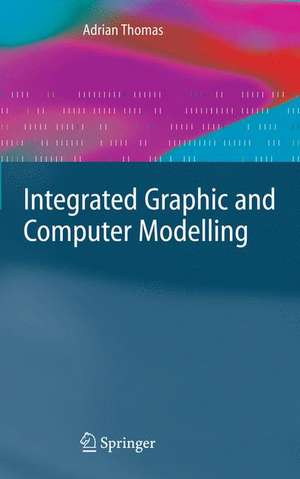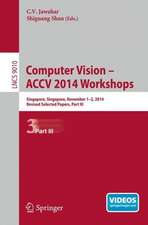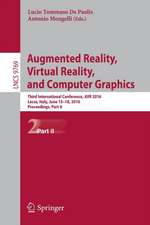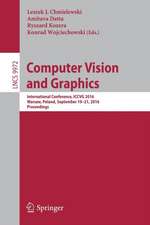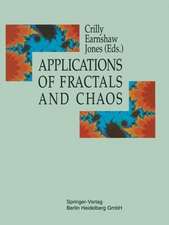Integrated Graphic and Computer Modelling
Autor Adrian Thomasen Limba Engleză Hardback – 10 sep 2008
| Toate formatele și edițiile | Preț | Express |
|---|---|---|
| Paperback (1) | 352.67 lei 6-8 săpt. | |
| SPRINGER LONDON – 13 dec 2014 | 352.67 lei 6-8 săpt. | |
| Hardback (1) | 364.25 lei 6-8 săpt. | |
| SPRINGER LONDON – 10 sep 2008 | 364.25 lei 6-8 săpt. |
Preț: 364.25 lei
Preț vechi: 455.30 lei
-20% Nou
Puncte Express: 546
Preț estimativ în valută:
69.72€ • 72.51$ • 58.42£
69.72€ • 72.51$ • 58.42£
Carte tipărită la comandă
Livrare economică 14-28 martie
Preluare comenzi: 021 569.72.76
Specificații
ISBN-13: 9781848001787
ISBN-10: 1848001789
Pagini: 708
Ilustrații: XXI, 685 p.
Dimensiuni: 155 x 235 x 34 mm
Greutate: 1.29 kg
Ediția:2008
Editura: SPRINGER LONDON
Colecția Springer
Locul publicării:London, United Kingdom
ISBN-10: 1848001789
Pagini: 708
Ilustrații: XXI, 685 p.
Dimensiuni: 155 x 235 x 34 mm
Greutate: 1.29 kg
Ediția:2008
Editura: SPRINGER LONDON
Colecția Springer
Locul publicării:London, United Kingdom
Public țintă
GraduateCuprins
Models: Language, Graphic, Analogue, Scale, Mathematical & Computer Models.- Computer Languages: & Java Programming.- Programming Development Environment for Graphics.- Conditional Action-Spatial Searching & Problem Solving.- Display System and Hardware Programming Primitives.- Computer Hardware and Low Level Machine Language Programming.- Intermediate, Assembler Language Programming Macro Expansions, and Expression Translation.- Higher Level Languages – Translation, Interpretation and Scripting.- Primitive, Raster- Infill Operations: Line Interpolation.- Area Fill, Masks, Circles and Thick Line Interpolation.- Parametric Line Interpolation & Keyframe Infill “Inbetweening” Film Animation.- Geometry, Algebras, Co-ordinate Systems, and Transformations.- Spatial Relationships Overlap & Adjacency: Point to Line to Area.- Spatial Relationships Overlap & Adjacency Polygon on Polygon.- Spatial Relationships Overlap & Adjacency Rectangle-Rectangle Window on Window.- GUI: Graphic User Interfaces: Control Design Animation & Simulation Systems.
Recenzii
From the reviews:
"The book provides a coherent introduction to the area of computer graphics … and whose original role in communication, design, entertainment and art has broadened to include a wide spectrum of applications. … There are two communities of readers for the book. Those who can produce graphics manually, or within a graphics painting or drawing environment … . And those who can program computers and therefore are accustomed to working in this way … . The book is full of color illustrations and Java code." (Agineszka Lisowska, Zentrablatt MATH, Vol. 1153, 2009)
"The book provides a coherent introduction to the area of computer graphics … and whose original role in communication, design, entertainment and art has broadened to include a wide spectrum of applications. … There are two communities of readers for the book. Those who can produce graphics manually, or within a graphics painting or drawing environment … . And those who can program computers and therefore are accustomed to working in this way … . The book is full of color illustrations and Java code." (Agineszka Lisowska, Zentrablatt MATH, Vol. 1153, 2009)
Textul de pe ultima copertă
The area of Computer Graphics has evolved over time and its original role in communication, design, entertainment and art has broadened to include a wide spectrum of applications including education, computer games, films and videos, medical applications, geographic information systems and much else besides. There has long been a need for a comprehensive book that provides a coherent introduction to this fast-moving area, and Adrian Thomas's beautifully illustrated and well-written work does just that.
Full colour throughout, the book explores programming language developments from machine code to more natural language forms, and the basic display operations and commands needed to create effective computer graphic systems. As the visual presentation of real and virtual environments becomes more and more the norm in application systems, a clear understanding of the theory that underpins these techniques is required of all students and practitioners studying and working on large computer systems.
A particular example is provided showing how interactively building a graphic model of a system can be used to construct a matching computer model of the system capable of demonstrating its behavior. This illustrates a powerful new range of design and simulation tools that arise from integrating computer and graphic modeling schemes.
Containing detailed programming examples along with an exploration of alternative algorithms to illustrate design options when building computer systems, this book provides a unique introduction to the complexities of integrating graphic and computer modeling and will be welcomed by all those interested in the way computers can be programmed to create images and environments.
Full colour throughout, the book explores programming language developments from machine code to more natural language forms, and the basic display operations and commands needed to create effective computer graphic systems. As the visual presentation of real and virtual environments becomes more and more the norm in application systems, a clear understanding of the theory that underpins these techniques is required of all students and practitioners studying and working on large computer systems.
A particular example is provided showing how interactively building a graphic model of a system can be used to construct a matching computer model of the system capable of demonstrating its behavior. This illustrates a powerful new range of design and simulation tools that arise from integrating computer and graphic modeling schemes.
Containing detailed programming examples along with an exploration of alternative algorithms to illustrate design options when building computer systems, this book provides a unique introduction to the complexities of integrating graphic and computer modeling and will be welcomed by all those interested in the way computers can be programmed to create images and environments.
Caracteristici
Includes graphics algorithms and data structures presented in a programming context Uses Java with lots of figures Includes supplementary material: sn.pub/extras
